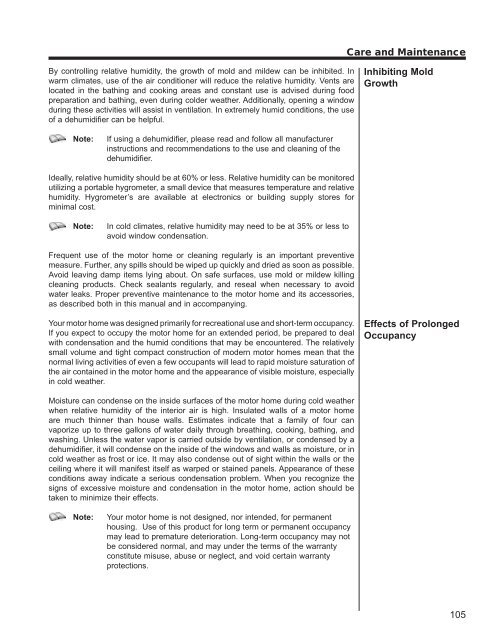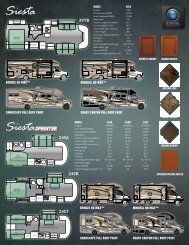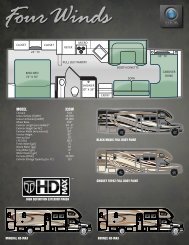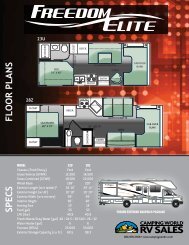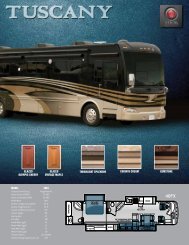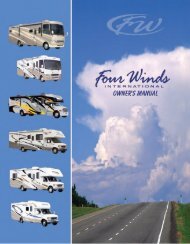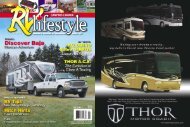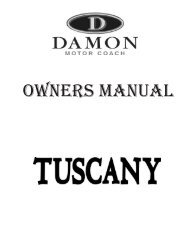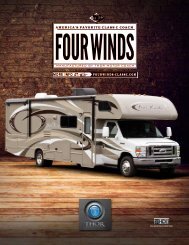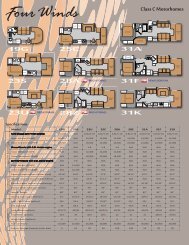caution - Thor Motor Coach
caution - Thor Motor Coach
caution - Thor Motor Coach
You also want an ePaper? Increase the reach of your titles
YUMPU automatically turns print PDFs into web optimized ePapers that Google loves.
By controlling relative humidity, the growth of mold and mildew can be inhibited. In<br />
warm climates, use of the air conditioner will reduce the relative humidity. Vents are<br />
located in the bathing and cooking areas and constant use is advised during food<br />
preparation and bathing, even during colder weather. Additionally, opening a window<br />
during these activities will assist in ventilation. In extremely humid conditions, the use<br />
of a dehumidifier can be helpful.<br />
Note: If using a dehumidifier, please read and follow all manufacturer<br />
instructions and recommendations to the use and cleaning of the<br />
dehumidifier.<br />
Ideally, relative humidity should be at 60% or less. Relative humidity can be monitored<br />
utilizing a portable hygrometer, a small device that measures temperature and relative<br />
humidity. Hygrometer’s are available at electronics or building supply stores for<br />
minimal cost.<br />
Note: In cold climates, relative humidity may need to be at 35% or less to<br />
avoid window condensation.<br />
Frequent use of the motor home or cleaning regularly is an important preventive<br />
measure. Further, any spills should be wiped up quickly and dried as soon as possible.<br />
Avoid leaving damp items lying about. On safe surfaces, use mold or mildew killing<br />
cleaning products. Check sealants regularly, and reseal when necessary to avoid<br />
water leaks. Proper preventive maintenance to the motor home and its accessories,<br />
as described both in this manual and in accompanying.<br />
Your motor home was designed primarily for recreational use and short-term occupancy.<br />
If you expect to occupy the motor home for an extended period, be prepared to deal<br />
with condensation and the humid conditions that may be encountered. The relatively<br />
small volume and tight compact construction of modern motor homes mean that the<br />
normal living activities of even a few occupants will lead to rapid moisture saturation of<br />
the air contained in the motor home and the appearance of visible moisture, especially<br />
in cold weather.<br />
Moisture can condense on the inside surfaces of the motor home during cold weather<br />
when relative humidity of the interior air is high. Insulated walls of a motor home<br />
are much thinner than house walls. Estimates indicate that a family of four can<br />
vaporize up to three gallons of water daily through breathing, cooking, bathing, and<br />
washing. Unless the water vapor is carried outside by ventilation, or condensed by a<br />
dehumidifier, it will condense on the inside of the windows and walls as moisture, or in<br />
cold weather as frost or ice. It may also condense out of sight within the walls or the<br />
ceiling where it will manifest itself as warped or stained panels. Appearance of these<br />
conditions away indicate a serious condensation problem. When you recognize the<br />
signs of excessive moisture and condensation in the motor home, action should be<br />
taken to minimize their effects.<br />
Note: Your motor home is not designed, nor intended, for permanent<br />
housing. Use of this product for long term or permanent occupancy<br />
may lead to premature deterioration. Long-term occupancy may not<br />
be considered normal, and may under the terms of the warranty<br />
constitute misuse, abuse or neglect, and void certain warranty<br />
protections.<br />
Care and Maintenance<br />
Inhibiting Mold<br />
Growth<br />
Effects of Prolonged<br />
Occupancy<br />
105


